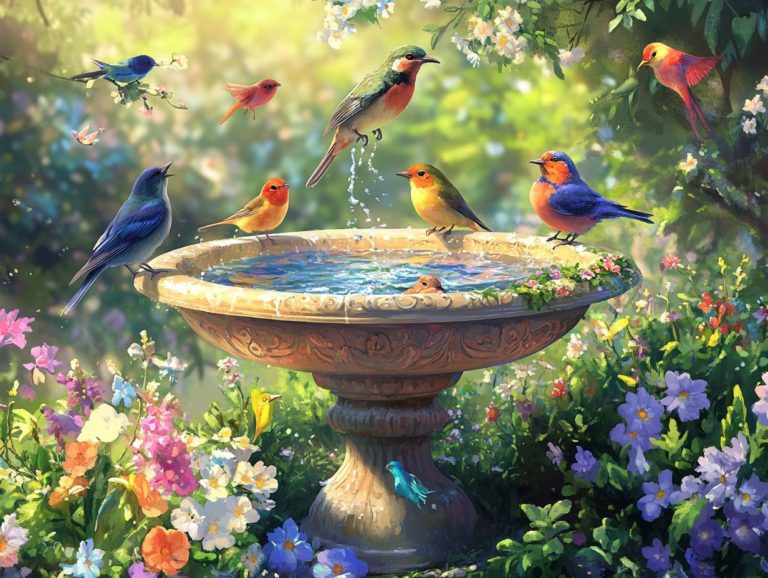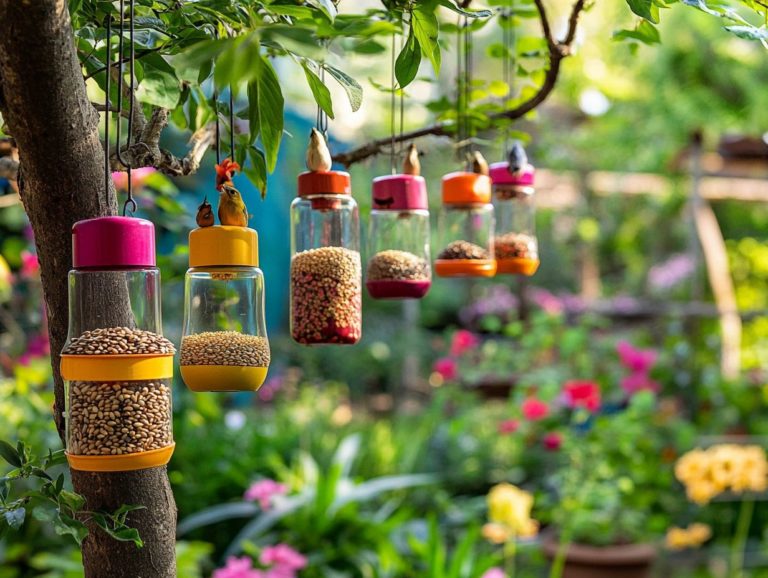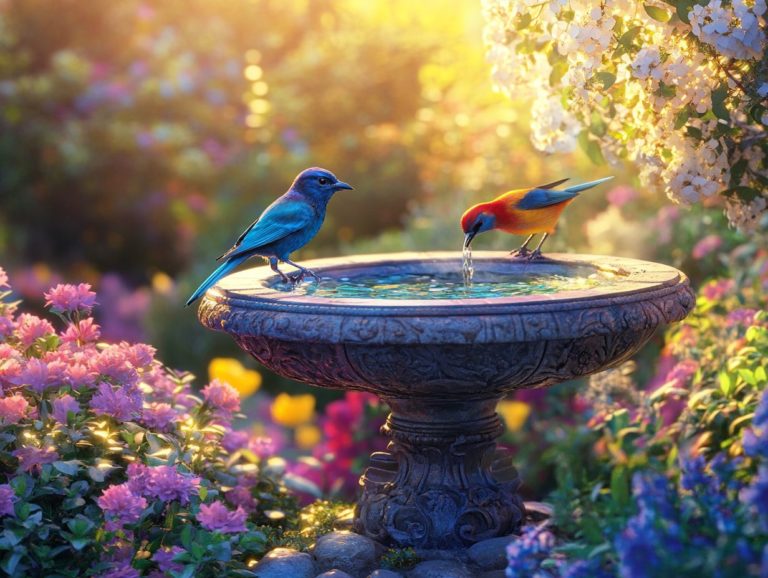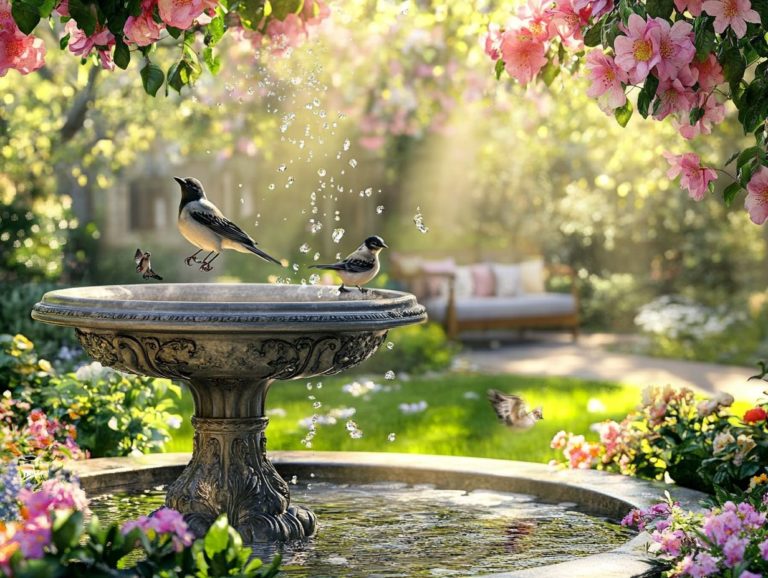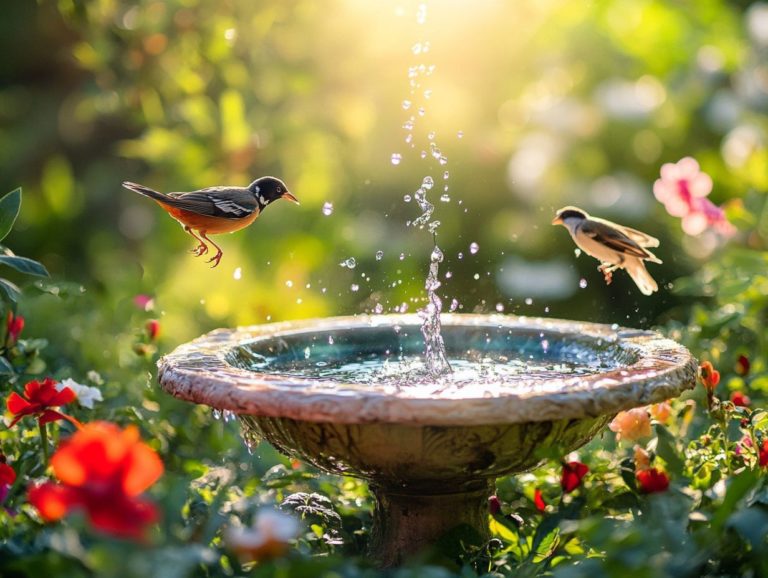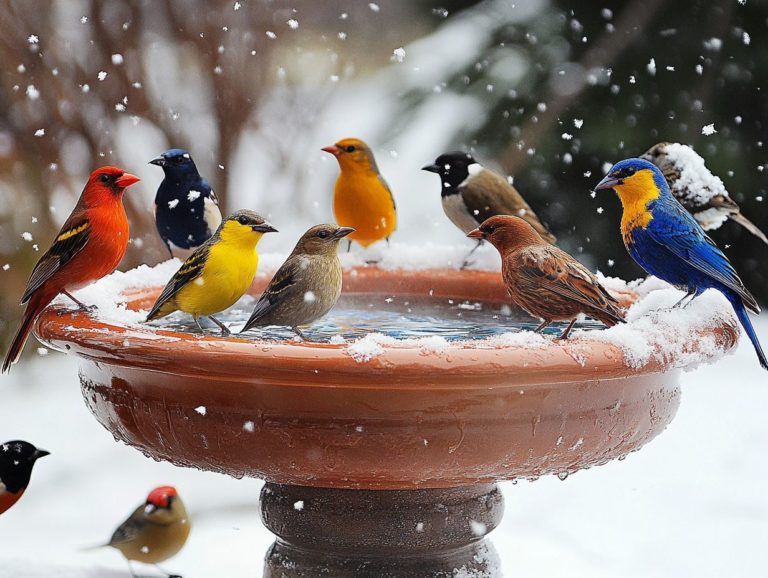5 Must-Have Features for Bird Feeders
Are you prepared to turn your backyard into a vibrant bird sanctuary? Selecting the right bird feeder is crucial, as not all feeders are designed the same way.
This guide will spark your interest in five essential features that will enrich your birdwatching experience and draw in a delightful array of birds. From robust materials to clever squirrel-proof designs, it provides all the insights you need.
This guide answers common questions about bird feeders, ensuring you re fully equipped to create a safe haven for your birds while keeping in mind that clean feeders are essential for their health. Immerse yourself in this knowledge and discover how to elevate your backyard birdwatching experience!
Contents
- Key Takeaways:
- 1. Durable and Weather-Resistant Materials
- 2. Easy to Clean and Maintain
- 3. Multiple Feeding Ports
- 4. Adjustable Perches to Accommodate Different Bird Sizes
- 5. Ability to Keep Squirrels and Other Pests Out
- What Are the Benefits of Having a Bird Feeder?
- Frequently Asked Questions
- What are the five must-have features for bird feeders?
- Why is sturdy construction important for bird feeders?
- What is proper drainage and why is it important for bird feeders?
- Why is easy refill access necessary for bird feeders?
- What type of perches should bird feeders have?
- How can I squirrel-proof my bird feeder?
Key Takeaways:
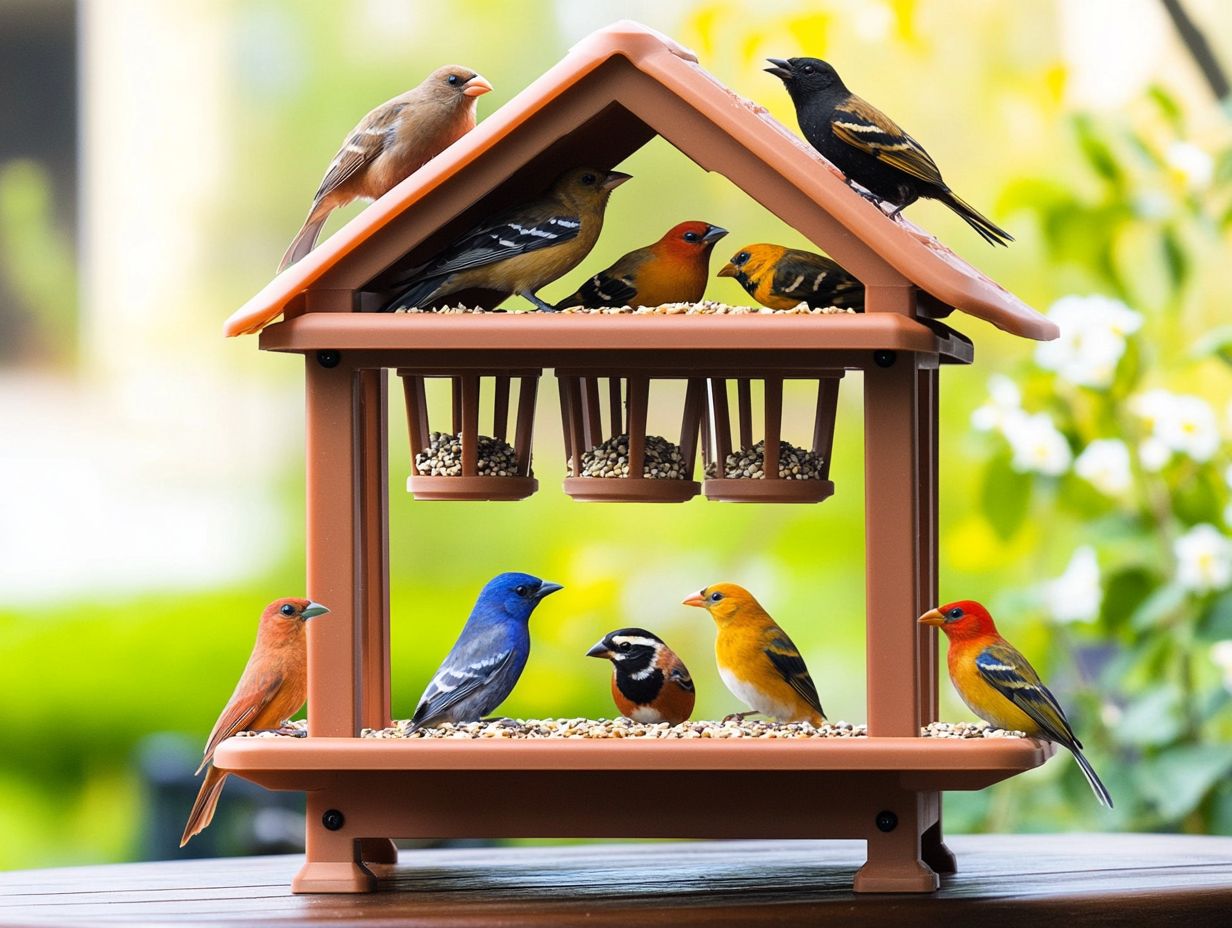
- Invest in a bird feeder made from durable, weather-resistant materials to ensure longevity and protection against the elements.
- Look for easy-to-clean and maintain bird feeders to keep them hygienic and safe for birds.
- Choose a feeder with multiple feeding ports to accommodate a variety of bird species and avoid overcrowding.
1. Durable and Weather-Resistant Materials
Investing in a bird feeder made from durable and weather-resistant materials is crucial for attracting wild birds to your backyard. This ensures that your feeder can withstand the elements while providing a reliable food source for seasonal visitors like woodpeckers, cardinals, and juncos. For inspiration, check out the top 10 most popular bird feeder designs.
Such an investment enhances your birdwatching experience and promotes the health and safety of the birds you wish to attract.
When selecting materials, consider the unique benefits of metal, plastic, and wood. Metal feeders, for example, are particularly resistant to rust and corrosion, making them perfect for rainy or snowy conditions.
Plastic options are lightweight and impervious to moisture, helping them retain their shape and color over time. Meanwhile, wooden feeders, especially those treated for weather resistance, offer a natural aesthetic appeal and can endure various climates when properly maintained.
By choosing these materials, you significantly boost the longevity of your feeder, reducing the need for replacements and ensuring birds have access to food throughout the year.
2. Easy to Clean and Maintain
Keeping your bird feeders clean and well-maintained is essential for both the health of the birds and the overall enjoyment of your birdwatching experience. After all, dirty feeders can lead to the spread of diseases among wild birds.
Regular cleaning is not just a chore; it’s crucial to ensure that your feeding stations provide a safe haven, free from mold and bacteria. To maintain your feeders effectively, opt for mild soap and warm water steer clear of harsh chemicals that could harm the very birds you want to attract.
Choosing feeders with removable bases and dishwasher-safe materials can make this task significantly easier. Considering pole-mounting feeders can also simplify cleaning, turning it into a quick and hassle-free experience.
By adopting these best practices, get ready to enjoy a lively parade of vibrant birds while minimizing the risk of disease transmission from neglected feeding areas.
3. Multiple Feeding Ports
Bird feeders with multiple feeding ports can dramatically enhance your chances of attracting a delightful variety of wild birds to your backyard. This setup allows you to offer a diverse mix of seeds simultaneously to species like orioles, hummingbirds, and finches. To ensure a successful installation, it’s helpful to use the essential tools for bird feeder setup.
Not only does this arrangement enable various birds to enjoy a meal together, but it also reduces competition for food, which can often deter smaller species from approaching a feeder.
By providing an array of seeds think black oil sunflower seeds for the larger birds and thistle seeds that smaller finches adore you can cater to a wider spectrum of avian preferences, making it easier to attract birds to your yard.
As a result, this inclusive approach not only enriches the diversity of birdlife visiting your space but also transforms your outdoor view into a vibrant and lively spectacle right outside your window.
4. Adjustable Perches to Accommodate Different Bird Sizes
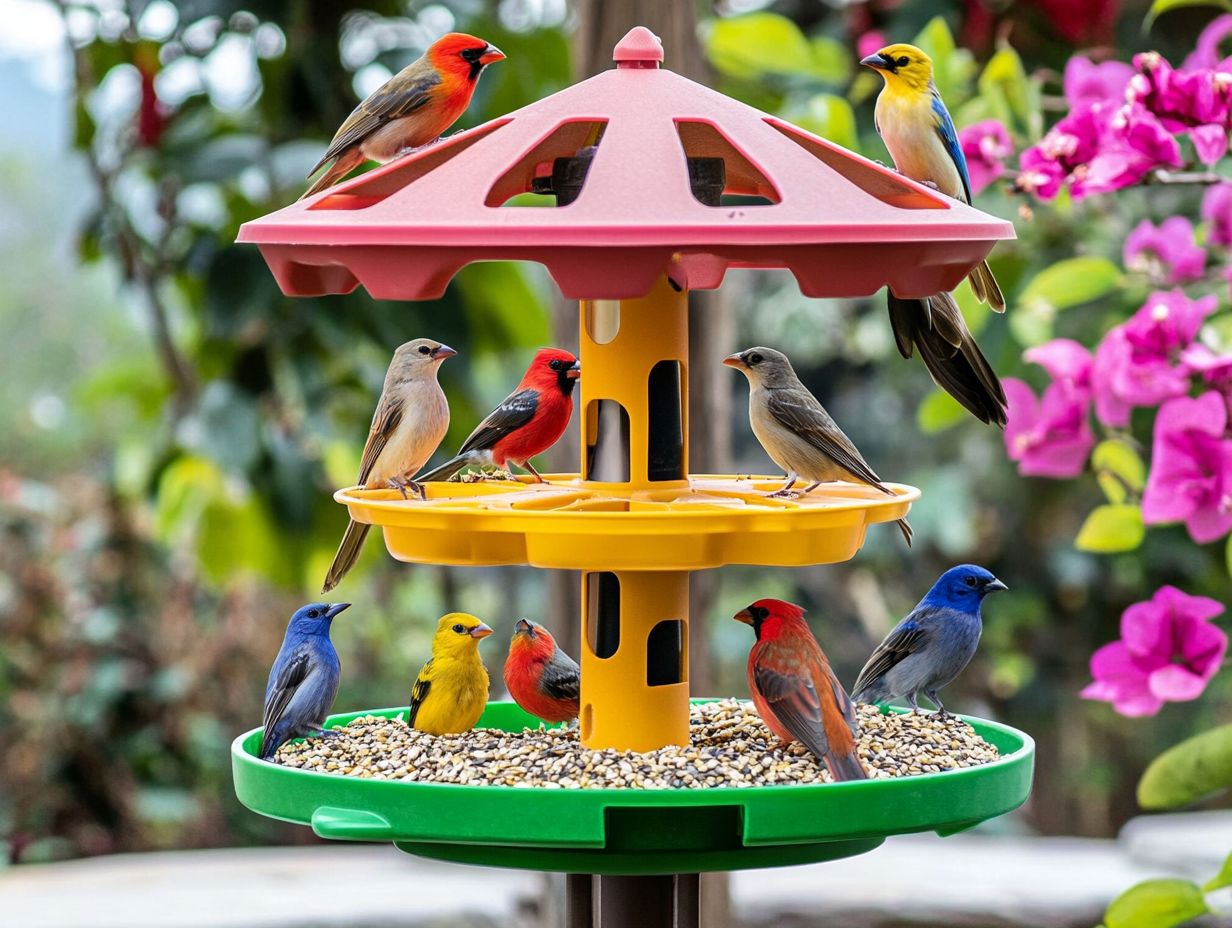
Incorporating adjustable perches into your bird feeder design is a brilliant move that caters to birds of all sizes. This feature allows small birds like juncos to feed comfortably alongside larger species such as woodpeckers, enhancing your backyard’s diversity.
This versatility not only attracts a diverse avian population but also enhances the overall usability of your feeders. By promoting inclusivity, these adjustable perches ensure that every feathered friend can easily access food, which is vital for their health and survival.
Designs that allow for quick modifications like parts that can be moved easily to adjust the size or interchangeable sections can meet the unique needs of various bird species. For instance, you can create wider perches for larger birds during peak feeding times, while adjusting to narrower ones for smaller visitors, fostering a harmonious feeding environment.
Act now to create a vibrant feeding space that birds can’t resist!
5. Ability to Keep Squirrels and Other Pests Out
A squirrel-resistant bird feeder is an essential asset for any birdwatching enthusiasts. It effectively keeps those pesky backyard intruders squirrels, raccoons, and feral cats at bay, ensuring that your beloved wild birds can access their food without interruption.
These specialized feeders come equipped with clever features such as perches that close off access when a heavier animal tries to land or enclosed designs that create a safe haven for the birds. For those interested in enhancing their bird-watching experience, checking out the top 5 bird feeders for backyard bird watching can help. Backyard pests can wreak havoc on feeding sessions, often scaring off the smaller birds and devouring all the food.
By investing in feeders that showcase must-have features in a bird watching scope, you can cultivate a wider variety of species to your feeders, making every visit a delightful occasion.
What Are the Benefits of Having a Bird Feeder?
Having a bird feeder in your backyard opens up a world of benefits, from attracting a delightful variety of wild birds to enriching your experience as a birdwatching enthusiast. This little addition can transform your backyard and is truly a worthwhile long-term investment for anyone who cherishes nature.
This addition promotes biodiversity by supporting various species and provides a reliable food source for birds. Engaging in birdwatching has been shown to enhance mental well-being, allowing you to connect with nature and savor moments of tranquility.
You might also find long-term financial savings by gardening without pesticides, as bird feeders naturally assist in controlling pests. Plus, this shared passion for birdwatching often sparks community engagement, where enthusiasts exchange tips and stories, forging connections over their love for these enchanting feathered companions.
Get your bird feeder today and start enjoying the beauty of nature right at your doorstep!
What Types of Birds Can Be Attracted to a Bird Feeder?
Bird feeders have the remarkable ability to attract a diverse array of bird species, from seasonal visitors like hummingbirds and orioles to the ever-charismatic woodpeckers. Each of these avian guests is drawn by specific food offerings whether it s the sweet nectar, hearty seeds, or indulgent suet.
To truly enhance your birdwatching experience, it s important to consider the unique preferences of these feathered friends. For instance, goldfinches have a particular fondness for thistle seeds. Cardinals often find black oil sunflower seeds irresistible, showcasing the importance of offering a diverse mix of seeds.
As winter approaches, woodpeckers will be drawn to suet cakes from suet feeders, which provide much-needed energy as temperatures drop. Positioning your feeders thoughtfully is crucial.
Aim for a quiet yet visible location, ideally near natural cover for added safety. Timing your feedings to align with seasonal changes can make a significant difference. In spring and summer, a vibrant mix of colors and food types will entice an array of lively species.
Conversely, during the colder months, adopting a more streamlined approach with high-energy foods will keep your visitors well-fed and returning for more.
Explore the Exciting Types of Bird Feeders!
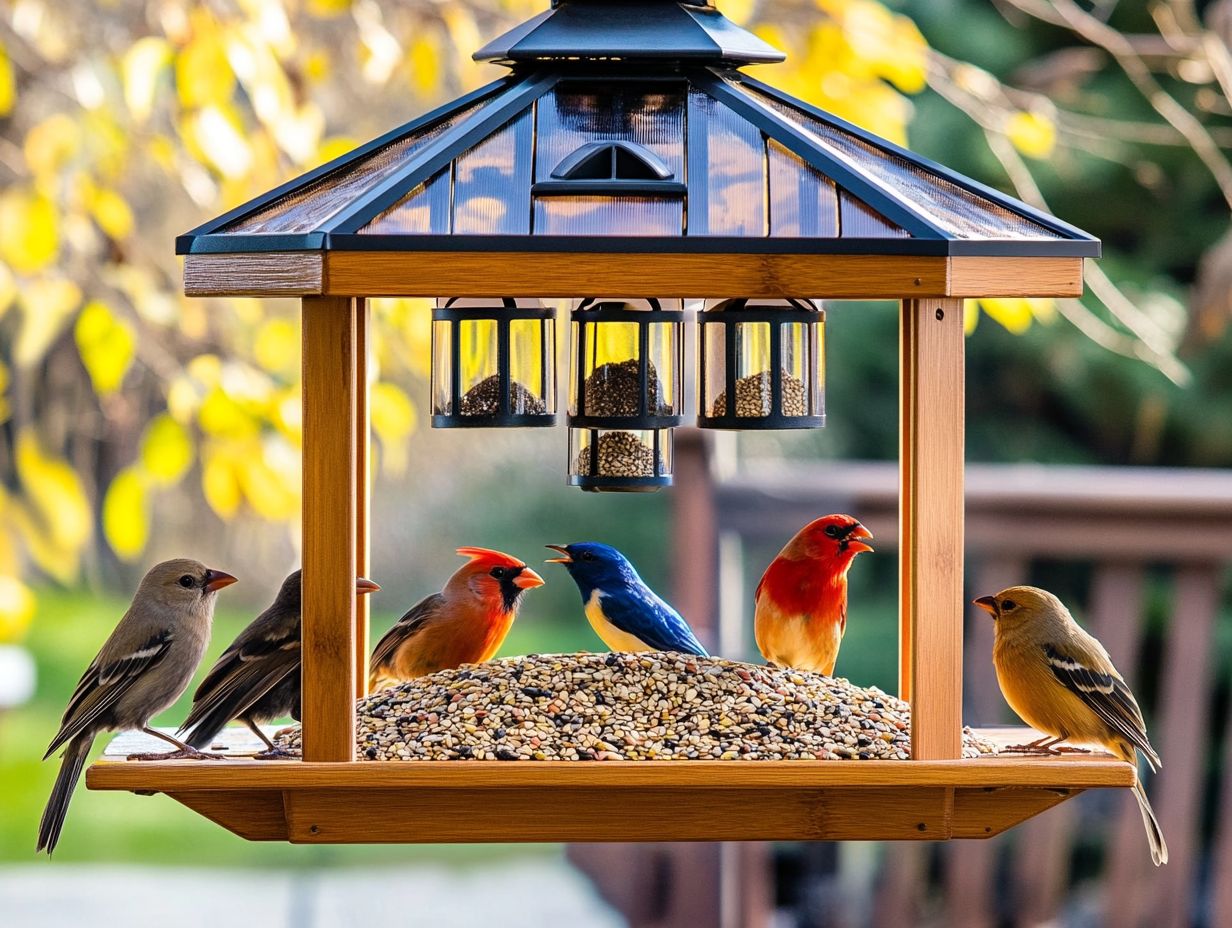
Discover a variety of bird feeders designed just for your feathered friends! You can choose from hopper feeders, tube feeders, suet feeders, nyjer feeders, fruit feeders, and nectar feeders, all tailored to meet the specific feeding preferences of different bird species.
For example, hopper feeders provide ample space for a variety of seeds, making them a magnet for songbirds like cardinals and finches. Tube feeders, which are narrow, are designed for small seed-eaters like chickadees and nuthatches, allowing them to easily access their favorite snacks through the ports.
Suet feeders, brimming with high-energy suet cakes, are perfect for woodpeckers and insectivorous birds, especially when temperatures dip. Nyjer feeders feature tiny openings that dispense thistle seeds adored by goldfinches and their finchy companions.
Fruit feeders are a delight for fruit-loving birds like orioles and mockingbirds, while nectar feeders cater to hummingbirds, offering the sweet sustenance they need as high-energy flyers.
Each type of feeder not only satisfies specific dietary needs but also elevates your overall birdwatching experience right in your own backyard, especially when paired with the right gear, like bird watching binoculars.
How Can One Ensure the Safety of Birds While Using a Bird Feeder?
Ensuring the safety of birds while using a bird feeder involves some straightforward, common sense practices. Regularly cleaning and sanitizing the feeder helps prevent the spread of diseases and protects birds from backyard pests like squirrels and feral cats.
To enhance the feeding experience for your feathered friends, consider the strategic placement of your feeders. Using several feeders can also improve the experience by catering to different feeding preferences. Choosing locations away from dense shrubs where predators might lurk is essential to minimize the risk of surprise attacks.
Incorporating baffles, which are barriers that prevent squirrels from accessing food, or a squirrel-resistant feeder can effectively deter unwanted visitors, allowing birds to feed in peace. Don t wait! Check your feeder regularly for mold or spoiled seeds to prevent health issues, and having fresh water sources nearby will keep your avian visitors well-hydrated.
By taking these precautions, you can cultivate a nurturing habitat that ensures both safety and enjoyment for your delightful avian guests.
Avoid These Common Mistakes When Using a Bird Feeder!
Many birdwatchers unknowingly stumble into pitfalls that hinder their efforts to attract and nurture wild birds. Neglecting to clean feeders regularly, using the wrong types of seeds, or placing feeders in less-than-ideal locations can all have detrimental effects.
These oversights can create feeding environments that are uninviting or even harmful to birds, discouraging visits and disrupting their natural behaviors. To avoid this, clean feeders regularly and ensure you have a variety of attractive feeders.
If you place feeders in areas with heavy activity or adverse weather, you may deter shy species like cardinals and juncos, which would otherwise flock to your generous offerings. Choosing high-quality, appropriate seed blends, such as black oil sunflower seeds or thistle seeds, is equally essential; inferior options might lack the necessary nutrients your feathered friends need.
Regularly cleaning feeders ideally every two weeks prevents mold growth and reduces the risk of spreading diseases among birds, ensuring that your backyard becomes a thriving haven for these beautiful creatures.
How Can One Make Their Own Bird Feeder at Home?
Creating your own bird feeder at home is a fun and rewarding DIY project. It also allows you to design attractive feeders that cater to the diverse feeding needs of wild birds.
By using materials you already have around the house like plastic bottles, wood scraps, or even old mugs you can unleash your creativity. Craft unique designs that serve a functional purpose while adding charm to your garden. This can include tube feeders or suet feeders. This delightful process is a wonderful way to engage children or friends with nature, fostering a love for wildlife.
Consider the specific bird species you wish to attract, such as hummingbirds or woodpeckers. Customize your feeders with holes and perches tailored to their size and feeding habits. This ensures a more enticing dining experience for your feathered visitors. Not only does this approach promote eco-friendly methods, but it also enhances the local ecosystem by providing essential food sources for various bird populations and encouraging seasonal visitors to your yard.
Frequently Asked Questions
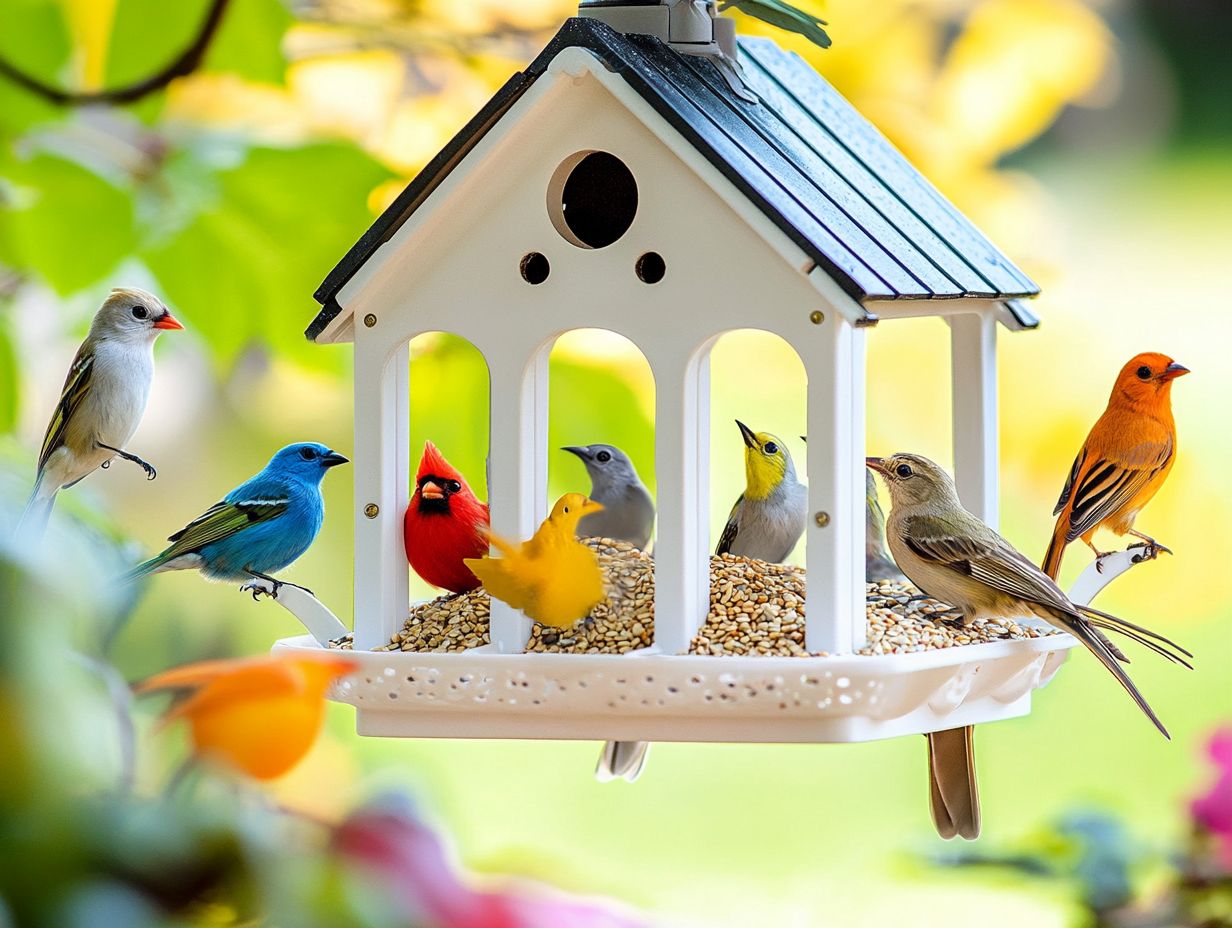
What are the five must-have features for bird feeders?
The five must-have features for bird feeders are sturdy construction, proper drainage, easy refill access, appropriate perches, and squirrel-proofing. Investing in a squirrel-resistant feeder is a smart choice for bird enthusiasts, as highlighted in the top 5 reasons to love bird feeders.
Why is sturdy construction important for bird feeders?
Sturdy construction is crucial because it ensures the feeder can withstand the weight of birds, including heavier species like raccoons, and endure harsh weather conditions.
What is proper drainage and why is it important for bird feeders?
Proper drainage refers to the ability for water to flow out of the feeder, preventing mold and bacteria growth. This keeps your feeders clean and easy to maintain, ensuring the feed remains fresh and healthy for birds.
Why is easy refill access necessary for bird feeders?
Easy refill access allows for quick and convenient refilling of the feeder, making maintenance simpler and encouraging birds to return for food.
What type of perches should bird feeders have?
Bird feeders should have perches that are suitable for the size of the birds you aim to attract. To learn more about choosing the right features, consider understanding bird feeder preferences. They should also be sturdy and comfortable for birds to rest on while they feed.
How can I squirrel-proof my bird feeder?
Squirrel-proof your bird feeder by using squirrel baffles or placing it in hard-to-reach locations. Consider feeders with weight-activated perches that close when a squirrel tries to access them, ensuring that only birds, like orioles and hummingbirds, can feed freely.
Start your bird feeder project today and enjoy the beauty of backyard wildlife!

